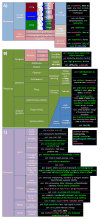In search of a periodic table of the neurons: Axonal-dendritic circuitry as the organizing principle: Patterns of axons and dendrites within distinct anatomical parcels provide the blueprint for circuit-based neuronal classification
- PMID: 27516119
- PMCID: PMC5148124
- DOI: 10.1002/bies.201600067
In search of a periodic table of the neurons: Axonal-dendritic circuitry as the organizing principle: Patterns of axons and dendrites within distinct anatomical parcels provide the blueprint for circuit-based neuronal classification
Abstract
No one knows yet how to organize, in a simple yet predictive form, the knowledge concerning the anatomical, biophysical, and molecular properties of neurons that are accumulating in thousands of publications every year. The situation is not dissimilar to the state of Chemistry prior to Mendeleev's tabulation of the elements. We propose that the patterns of presence or absence of axons and dendrites within known anatomical parcels may serve as the key principle to define neuron types. Just as the positions of the elements in the periodic table indicate their potential to combine into molecules, axonal and dendritic distributions provide the blueprint for network connectivity. Furthermore, among the features commonly employed to describe neurons, morphology is considerably robust to experimental conditions. At the same time, this core classification scheme is suitable for aggregating biochemical, physiological, and synaptic information.
Keywords: axons; circuits; classification; dendrites; neurons.
© 2016 WILEY Periodicals, Inc.
Conflict of interest statement
None of the authors has a conflict of interest to declare.
Figures




References
-
- Denk W, Briggman KL, Helmstaedter M. Structural neurobiology: missing link to a mechanistic understanding of neural computation. Nat Rev Neurosci. 2012;13:351–8. - PubMed
Publication types
MeSH terms
Grants and funding
LinkOut - more resources
Full Text Sources
Other Literature Sources

